What is the worst you can imagine?

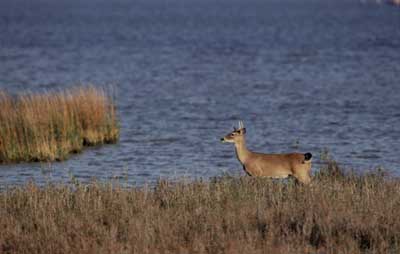
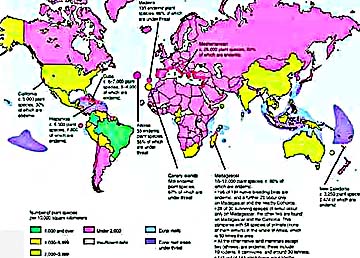
Two essays.
What is the worst you can imagine? |
 |
||
| Wetlands are not wastelands | |||

|

|
||
Converging planetary problems in the midst of quickening Global Change
World Meteorological Organization report
CFC levels are now slowly dropping due to emissions reductions set under the United Nations Montreal Protocol on Substances that Deplete the Ozone Layer that entered into force in 1989.
400 parts per million CO2 Carbon dioxide leels reached: .
Carbon dioxide reached 383.1 parts per million (ppm), an increase of 0.5 percent from 2006, according to the latest numbers in the World Meteorological Organization report.
• Concentrations of nitrous oxide also reached record highs in 2007, up 0.25 percent from the year before.
• Methane levels increased 0.34 percent, exceeding the highest value so far, which was recorded in 2003.
• Using the annual greenhouse gas index issued by the U.S. National Oceanic and Atmospheric Administration, NOAA, the total warming effect of all long-lived greenhouse gases was calculated to have increased by 24.2 percent since 1990 and by 1.06 percent from the previous year.
Since the mid-18th century, carbon dioxide concentrations in the atmosphere have risen 37 percent, the WMO report shows.
Key issues facing many governments include the following:
The Educational Significance of Global Change
by Joseph Siry
The problems associated with the concept of planetary shifts in climate, temperature,
pressure and humidity has serious implications for soil moisture, radiation
exposure, and perturbation of drought and flood cycles. These altered physical
conditions are serious because of their direct influence on the crops comprising
local food supplies and international trade in food and vegetable crops.
They too influence how we should learn about our impact on the planet since it is obvious that humans have induced global warming by interfering with the rate and distribution of the elementary carbon cycle.
The threat to food provisions is more than hyperbolic expressions of as
yet unaccountable risks faced by growing populations. Edward O. Wilson,
experimental biologist, argues that "Very few of the species with potential
economic importance actually reach world markets....20 species provide 90
percent of the world's food and just three -- wheat, maize, and rice --
supply more than half." And then in relating this thin green lifeline
to biogeography he comments that "This cushion of diversity is biased
toward cooler climates, and in most parts of the world it is sown in monocultures
sensitive to disease." (Wilson, 288) Biological diversity in this view
acts as insurance.
Given the problem expressed by the Committee on the Human Dimensions of
Global Change as "the depletion of the ozone layer attributed to the
accumulation of chlorofluorocarbons (CFCs) in the stratosphere is an unintended
side effect of human industrial activities," (NRC, 17) Wilson's is
a sentinel viewpoint. The Committee argues that "For the first time,"
due to the increasing size of the arctic and antarctic ozone holes, the
increase in the carbon content of the atmosphere and the ongoing loss of
biological diversity "human beings.have begun to play a central role
in altering global biogeochemical systems and the earth as a whole."
The Committee of scientists and social scientists fears that "the earth
has entered a period of change that differs from previous episodes of global
change in the extent to which it is human in origin."
Climate expert W. John Maunder concludes that "We are certain of the
following:
There is a natural greenhouse effect which already keeps the earth warmer
than it would otherwise be." He refers to the initial assessment report
of the Intergovernmental Panel on Climate Change (IPCC) that :
"Emissions resulting from human activities are substantially increasing
the atmospheric concentrations of green house gases, carbon dioxide, methane,
chlorofluorocarbons (CFCs) and nitrous oxide. These increases will enhance
the greenhouse effect, resulting on average in an additional warming of
the Earth's surface. The main greenhouse gas, water vapor,will increase
in response to global warming and further enhance it." (Maunder, 141)
The scope of and depth to which these risks exist will over the coming decades
increase the need to analytically determine and synthetically evaluate the
influence of these changes on the livelihoods of people. Such a methodology
requires the integration and interpretation of data from among traditionally
isolated disciplines within a behavioral and historical framework uncommon
among existing specialties except for oceanography, and to a limited extent
the microbiology and public health traditions.
To best equip a new generation of research and development into the threats
and potential opportunities involved in global climate change requires a
new pedagogy. Predictive explanations of ecological and behavioral responses
to global change rests on investigative methods that mesh quantitative reasoning,
critical thinking, visual interpretation and written expression. Language
acquisition and symbolic manipulation abilities are one cornerstone in the
incipient formulation of a new pedagogy required by the need "to focus
on human responses to to global changes." (NRC, 17) The experimental
nature of the changes in the biogeochemical milieu and of the adherent cultural
adaptations to surrounding conditions this necessitates a wedding of the
sciences and the arts at a sustained level of intimacy.
Pieces of the new pedagogy are beginning to congeal into what G. Tyler Miller
calls "the Spaceship-Earth Worldview in which the Earth is viewed as
a spaceship -- a machine that we can understand, dominate, and change at
will by using advanced technology." (Miller [1993], 27) But he warns
that this growing perspective in the environmental sciences is "an
upside-down view of reality. It thinks of the earth as a spaceship -- a
simple unsustainable human creation." The incipient stage of a new
pedagogical approach to redefining human behavior in the context of an internationally
unprecedented experimental alteration of our atmosphere, seas, and climate
requires a dialectical approach to learning characterized by Murray Gell-Mann,
theoretical physicist, as a corrective feedback approach to assessing information
inherent in all "complex adaptive systems." (Gell-Mann, 25) In
terms of Miller's approach to pedagogy the dialectical antithesis of the
spaceship-earth worldview is the sustainable earth worldview, a "life
centered approach," that conceptualizes "human beings as part
of nature -- not apart from nature," to rephrase Robinson Jeffers verse.
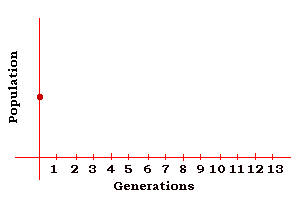
The dialectical thinking required by Gell-Mann's explication of the algorithmic
information content and effective complexity inherent in any data from both
natural and human systems forces learners to encourage debate. As Miller
advises we ought to "Put the poor and their environment first, not
last; help the poor sustain themselves and their local environment, and
do this with love not condescension." (Miller [1993], 29). Such an
approach to interpreting scientific data and implementing policy rests on
comprehending regional and cultural differences in the ways people symbolically
reconstruct their inhabited world. (Geertz [1973],170) Education for global
change insists that we learn more than a facility for problem solving as
the cornerstone of intellectual growth, instead it challenges us to provide
an emotional and motivational framework within which to articulate competing
ethical restraints upon our individual and collective behavior.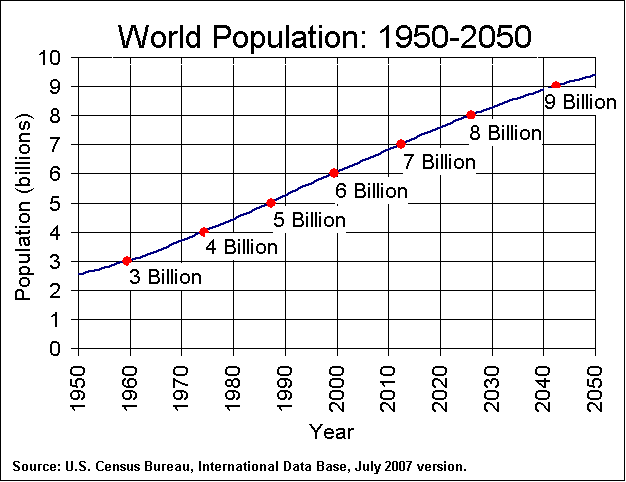
As embodied in the tenets of the World Conservation Strategy, the protection
of the planetary life support system and the promotion of biological diversity
will always encounter the necessity of providing adequate livelihoods for
communities whose people are and will be affected by erosion, desertification,
flooding, radiation and depletion of renewable resources. But historical
study of the responses to pestilence, urbanization, famine, and depopulation
reveals ample evidence against which to measure the predictive quality of
the negatable hypotheses that must form one basis of an emerging research
agenda. If the new pedagogy is to provide lasting interpretive value, then
it must increase our ability to handle ambiguity while promoting tolerance.
§§§
Sources Cited:
Clifford Geertz, The Interpretation of Culture, (New York: Harper Colophon,
1973).
Murray Gell-Mann, The Quark and the Jaguar, (San Francisco: Freeman, 1994).
W. John Maunder, Dictionary of Global Climate Change, (London:University
College of London Press, 1992).
G. Tyler Miller, Environmental Science, 4th ed. (Belmont: Wadsworth, 1993).
National Research Council, Global Environmental Change, (Washington. D.C.,
National Academy of the Science, 1992).
Edward O. Wilson, The Diversity of Life, (New York: Norton, 1992).
World Conservation Monitoring Center, Global Biodiversity, (London: Chapman
& Hall, 1992).
Works consulted:
Jacob Bronowski, Science & Human Values (1979)
Preston Cloud, Cosmos Earth & Man, (1973)
Freeman Dyson, Infinite in all Directions, (1988)
R. Buckminster Fuller, Operating Manual for Spaceship Earth ,(1963)
Garrett Hardin, Living within Limits, (1992); and Filters Against Folly,
(1990)
Humphrey Jennings, Pandaemonium, (1985)
Kai N. Lee, Compass & Gyroscope (1993)
Leo Marx,The Machine in the Garden (1964)
Charles Piller, The Fail Safe Society: Community Defiance and the end of
American Technological Optimism (1991)
Tjeerd Van Andel, Tales of an Old Ocean, (1977).
Converging Global Problems with local and national ecological dilemmas
requires a new approach to education called environmental management.
The value and objectives of Environmental Management
by Joseph Siry
In just our lifetimes the pace of social, technical, and ecological change
has altered the planet's atmosphere, the productive capacity of the oceans
and the viability of thousands of species. According to a report to the
University of California Regents, "The world faces important, growing
environmental challenges and needs scientists and policy makers who possess
the intellectual framework required to find solutions." The existing
academic fragmentation while achieving significant depth in comprehension
remains less than effective in providing the necessary foundations and frame
of reference from which to study human systems against the complexities
of climatic, hydrological and ecological variation.
The intellectual foundations and cognitive framework of Environmental Management
has as its goals the diagnosis, assessment, mitigation and remedy of environmental
problems that link together disciplines from the natural sciences, social
sciences and policy perspectives based on a rigorous analytical and synthetic
methodology. Students of environmental science should comprehend rational
management of ecological problems enabling practitioners to integrate three
related tasks. Initially investigation should enable learners to explain
the varied complexities of interrelated natural and human systems. This
base of information should then be used to evaluate the consequences of
existing and future industrial, municipal and agricultural endeavors. The
purpose of comprehending complexity to effectively evaluate patterns of
conservation and development is to better judge and resolve conflicts over
the contingent institutional and ethical dimensions of policy alternatives.
Graduates of such a program should be of immediate service to the community
at large by combining experience in computer assisted analysis, managerial
and financial accounting, environmental science and ecological problem solving.
Through the combined uses of field investigations, internships, laboratory
analyses, problem solving, writing and investigative research participants
in this learning venture would interpret, critique, formulate and redesign
existing industrial and governmental practices. In doing so environmental
managers would be equipped to effectively account for ecological costs and
social benefits. The practical application of skills and investigative techniques
through professional service to industry, government, business or commerce
is to enhance the student's cognitive and affective development by the frequent
use of analytical, accounting and expressive habits.
Ecological problem solving, as the core of environmental management practices,
requires a case study approach to apply varied investigative methods. Increasingly
environmental careers demand professionals who are experienced with interpreting
scientific, political and demographic language within a mixed context of
business oriented decision making and community constraints. By understanding
the local, regional and international contexts that operate to both disperse
and constrain biological and social behavior environmental education affords
a necessary interdisciplinary methods with which to interpret and implement
measures that protect human and ecological health while promoting sustainable
economic development.
Wetlands protection is a good example how present practices run counter
to long established historical traditions:

Wetlands are repositories
by Joseph Siry
Long regarded as valuable resources, the recent treatment of wetlands as
wastelands ignores the historically significant roles that these water logged
areas have always played in civilization. Frequently the rich accumulating
mud of lake, river, or ocean shores capture and sometimes preserve remnants
of our past.In the pair of footprints from the Laetoli site in East Africa
one may verify the upright stance and bipedal walk of human ancestors over
3.7 million years old.1 Bogs and lake mud have long held the pollen grains
that paleontologists use to understand the flora of antiquity and through
this reconstruction the climate of the recent past. The significance of
rice and papyrus, two wetland crops, in Asian and African civilizations
are an indication of the centrality of wetlands in preindustrial civilization.
Also trapped within the anoxic layers of the mud lie artifacts that suggest
the recurrent uses of wetlands for a variety of subsistence and commercial
uses long before the more recent view of marshlands as wastelands.
From the perspective of wetlands as a cache of artifacts a heritage of conflict
arises suggesting that these borderlands are anything but wastelands. As
items from the surrounding areas or adjacent watersheds are uncovered in
wetland deposits one may piece together the significant clash among incompatible
uses of wetlands. This heritage of competing uses of wetlands for fishing
and hunting versus their alteration for commercial development may be traced
archaeologically to the second century B.C. along the Tuscan shore of central
Italy. In the Roman port of Cosa a preindustrial enterprise existed to make
amphoras, process olives, and preserve fish. Built beside a Mediterranean
lagoon and a spring this port shipped food items throughout the region.
Remarkable as the marine engineering was the existence of sizable fish hatcheries.2
Far from being unproductive wastes the ancient uses, before Roman coastal
engineering, reveal wetlands to be centers of subsistence and commercial
activity. This recognition is discerned in mythology, archaeology, and the
current persistent occupation of riparian sites by the marsh Arabs of Iraq.
In Egyptian & Sumerian creation epics the world emerges from the mud
as the universal water recedes. Geb the Egyptian progenitor of the gods
is sometimes seen as a goose, the waterfowl whose egg engenders the birth
of the world. Similarly Thoth the Egyptian god of all knowledge, language
and land surveying is often pictured with the head of an ibis, a waterfowl.3
Such mythical associations of deities with wetland animals -- as in Egypt
-- suggest the emblematic centrality of the river Nile and its extensive
wetland delta in explaining the origins, traditions, and necessities of
this influential civilization.
Isis was referred to in prayers as the "Lady of the marshes,"
where an important raw material in Egyptian civilization grew, papyrus reeds.
"The papyrus reed was used as a universal material by Egyptians ...
it was more useful as it formed a substitute for wood , which was never
plentiful." Boats, mats, sandals and above all scrolls for writing
were crafted from the papyrus reeds that grew "in every marsh."
Naked workers would pull up the reeds from the mud along the edge fresh
water wetlands where the stalks would be bundled, dried and later worked
by crafts people into goods from floor mats to scrolls.4
Like the papyrus that flourish in wetlands, human subsistence was assured
by proximity to riparian or lake shores due to the domestication of rice
some 7000 years ago in Asia. Rice among the oldest of domesticated crops,
eaten by a majority of the world's population, was originally a wetland
grain crop. Among the most economically necessary crops rice was eaten,
fermented, made into paste and pressed into paper after its domestication
in the wetlands of southeast Asia. Evidence remains inconclusive as the
the primal origination of rice because prehistoric samples are available
from the Yangtze River Valley, central Thailand, and the Ganges River Valley
of nearly equal antiquity. Recently rice crops have nearly doubled in India
due to breeding and the "green revolution."5
The peoples of the Tigris and Euphrates River mouths, collectively referred
to as "marsh Arabs," have lived for centuries fishing, fowling
and using the marsh grasses for building extensive shelters and boats for
fishing and trade.6
The utilitarian importance of wetlands is not the only legacy of antiquity
and herein lies an origin of the dualistic belief about wetlands as at once
a refuge and an obstructing waste. Often the deposition of silt along rivers
that may give rise to wetlands is the result of deforestation and erosion
from cultivation of the watershed. Among the great cities of the Greaco-Roman
world Antioch and Ephesus were once sites of impressive harbors that silted
up and fell into disuse. About 300 B.C. Italy and Sicily were still well
forested, but the increasing demand for land and timber resulted in rapid
deforestation. The inevitable consequence was much higher levels of soil
erosion, and as the earth was carried down in the rivers, the gradual silting
up of ports in the estuaries.
In addition to the above ports, historian Clive Ponting states that, "The
port of Paestum in southern Italy silted up completely and the town decayed
while Ravenna lost its access to the sea."7 Given the extent of these
examples from Italy to Turkey, the establishment of Cosa, along the coast
north of Rome as a trading port is particularly important for its use of
the wetlands around lagoons to raise fish. Archaeologists have argued that
from the 2d through the 1st century B. C., Cosa was a "port of first
importance." Dr. Anna Marguerite McCann calls the site a "remarkable
commercial complex" in part because of the fact that "In the lagoon
behind the port the first Roman commercial fishery was found."8 Located
near a high promontory used to spot tuna migrations "the Harbor, which
was the cultural element of the complex, had been modified considerably
from the natural state by Roman engineers."
The Port of Cosa was also chosen near the site of a large fresh water spring,
where canals, a lighthouse and piers all suggest the "work of experienced
engineers who were quite familiar with local wave and current conditions."
Like the now silted ports of Antioch and Ephesus, Cosa reveals a marvelous
ability of ancient engineers to modify and improve wetlands for multiple
uses. The retention of a fishery beside the port is a clue to the Roman
Republic's early adaptation of wetlands for the raising of fish for salting,
pickling and the extraction of condiments. Dr. McCann believes that "the
discovery of a fish farm in the adjacent lagoon makes it clear that Cosa
was an industrial fishery in the 1st century B.C." These assumptions
are based on the excavation of "fish tanks of more than 100 meters
long covering about a hectare (2.47 acres) on the west end of the adjacent
lagoon." The magnitude of this construction sustained a prodigious
commercial venture. "In this way the Roman engineers made it possible
to raise and keep fish in large concrete tanks which could have yielded
about 150,000 kilograms of fish per year," according to Dr. McCann.9
While far from conclusive, the evidence from Cosa concerning ports, fisheries,
technology and commerce suggests that the Mediterranean people's use of
lagoons for fish farming added considerably to the protein requirements
of antiquity's population. The fish was preserved and distributed as far
as Gaul and Asia Minor in clay amphoras that were also made at the port
of Cosa. While olives and olive oil were the major article of trade archaeologists
assume that as much of a quarter of Cosa's commerce was in fish. These fish
required the nutrients available from the lagoon's wetlands, especially
at a young age, to grow into a commercially viable product. The remains
of eel traps and water lifting devices suggest the complexity, diversity,
and considerable investment of skill to maintain this ancient factory beside
the wetlands over two centuries.
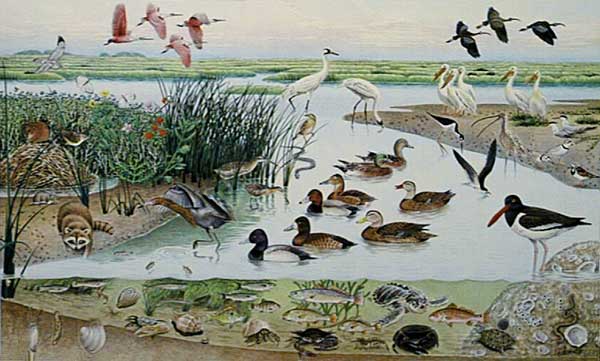
Current arguments over the values and uses of wetlands must be understood
in this longer historical context because these archaeological discoveries
reveal the inherent value of wetlands as a potential source for both useful
commercial alteration and aesthetic appreciation. While many have focused
on the obstructing maladies posed by wetlands to civilized progress, discoveries
such a Cosa suggest a more complicated mutualistic dependence of culture
on wetland landscapes. All too frequently wetlands have been viewed as a
measure of struggle and triumph over natural obstacles. For example Clive
Ponting notes that "A more extensive, difficult and long-lasting struggle
to create new land took place in the Netherlands."10 Long understood
as a successful example of reclamation to be imitated in Britain, France,
Germany, Russia, and the United States, the Dutch experience remains today
a powerful influence on the positive image of wetland alteration as a benefit
to civilization. No less an advocate of conservation than George Perkins
Marsh wrote in 1864, that, "by human power," reclaiming land from
the waters "man has achieved some of his most remarkable and honorable
conquests over nature." In referring to this type of engineering as
"harbor and coastal improvements, Marsh argued that they "must
take a very high rank among the great works of man."11
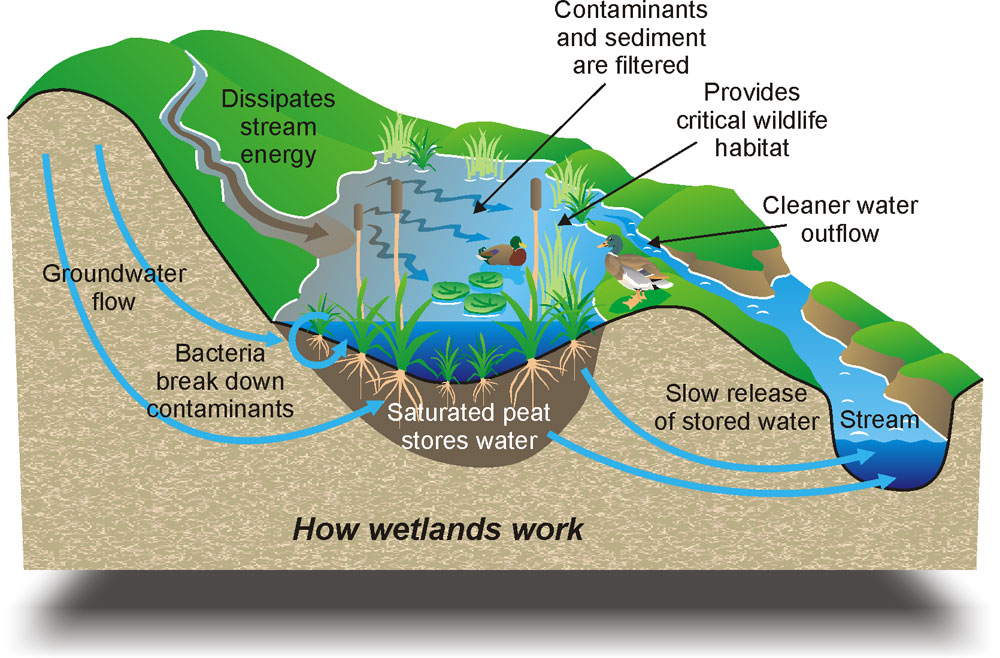
When viewed apart from the context of fish culture, wetland reclamation
appears to be a wholly beneficial use of resources for the spread of agriculture.
Yet when understood from an inherent functional perspective the physical,
biological, and chemical aspects of wetlands reveal important limits on
which some social uses are able to capitalize. In addition to aquiculture
or mariculture, sustained yield forestry, sport hunting and fishing or flood
protection are all beneficial uses of the physical properties of wetlands
requiring little or no reclamation. More recent historical developments
due to industrialization, urbanization, and modern chemical science have
put at a premium, the ability of wetlands to filter pollutants, restore
the dissolved oxygen of adjacent waters, and sustain life.12
In short, there is no inherently bad or good complex of uses dictated by
the physical conditions of wetlands. Each society observes the physical
and biological boundaries of wetland resources depending on the geographical
and vegetational characteristics of wetlands when matched by the technical
sophistication and social needs of the people using wetland areas.
Today the European influence on commercial cities built near wetlands around
the world including Venice, Stockholm, Boston, Bombay, Hong Kong, Singapore,
or Tokyo reveals the lucrative character of reclamation for such ports.
Given the values, population density, and technical capacity of these nations
to reclaim wetlands it is all too obvious why alteration has been equated
with progress since the sixteenth and eighteenth centuries. Due to the worldwide
extent of these wetland transformations in interfering with migratory bird
and fish populations the 1972, international agreement at Ramsar, Iran,
for the assessment, management, and protection of our remaining wetlands
is significant.13 In an economic sense as wetlands are increasingly scarce
common property resources they increase in value. By reclamation we ironically
enhance the value of remaining wetlands.
One writer, V. S. Naipaul, who in speaking of his native Trinidad, captures
the meaning of the modern transformation of wetlands with significant accompanying
insights. When he writes that "A new rubbish dump was established in
the black-water mangrove swamp at the east end of the city, on the other
side of the highway that ran through the shanty town."14 he reveals
an irony of development. As another archaeological measure of progress
the garbage heap all too often appears astride a wetland. As revealed by
Naipaul, "The people of the shanty town, men and women and children,
worked in this smoke -- emblematic silhouettes -- raking over the rubbish
for things that could be salvaged and sold." Like the developed world's
cities near wetlands -- in developing Trinidad some swamps are valuable
only a trash dumps. He laments that "It was as though, with the colonial
past, all the colonial landscape was being trampled over and undone."
Naipaul recalls that "During the war (WWII) the land had been occupied
by the Americans.The land had been reclaimed from the shallows of the Gulf
of Paria before the war: land built up on the pebble-less and very soft
black mud exposed at low tide. I remembered the reclamation taking place,
the dredge-up black mud of the Gulf drying out in cracked gray cakes. (And
long before that, and for hundreds of years, all this area, had been Cumucurapo,
an aboriginal Indian place.)" In Naipaul's beautiful prose the land
emerges as a layer cake, hiding in its oft flooded, folded and fissured
mud the revealing stratigraphy of our kind.
By using the tropical setting of Port of Spain, amidst the rare salt water
tolerant mangrove forests, Naipaul evokes a power we imaginatively associate
with landscape the power to define our cultural identity. He says in layered
landscape "I saw there was an immense chain of events. You could start
with the sacrament of the square and work back to the black madmen on the
benches, the Indian destitutes, the plantations, the wilderness, the aboriginal
settlements, the discovery. And you could move forward from that exaltation
and that mood of rejection to the nihilism of the moment."15 The
mangrove forest like the plantations it lies beside become for Naipaul the
repository of a memory, lost to many, who forget the deeper sweep of time.
Two critics of current land-use policy, Lynton Caldwell, co-author of the
National Environmental Policy Act, 1969, and philosopher Kristin Shrader-Frechette
argue that "the welfare of the individual is ultimately dependent upon
the viability of the life-supporting biological community. Impoverishment
of [the] natural world means impoverishment of all society dependent upon
it, individuals included." They use wetlands particularly to point
out "For example, to preserve wetlands and estuaries from being drained
or filled for dry-land uses is not to prefer ducks or muskrats to people.
It is rather to prefer the interests of the whole of society in a viable
relationship over those self-centered interests that would jeopardize the
biological community for immediate and personal economic gain."16
Thus have wetlands emerged as a measure of our ecological and ethical sophistication.
As important emblems of our contorted contest against the rising seas, wetlands
are common property resources that occupy that shifting border between water
and dry land. They defy facile understanding and easy solutions. Here in
the rubbish heap remain the allegedly valueless shards of our everyday existence
that only the archaeologist finds of greatest value. The wetland emerges
as a measure of our ability to discard and forget just as these garbage
heaps are milestone markers in the dim byways of our past. With Naipual's
vision of the landscape as a malleable object under the influence of human
capacities to alter nature wetlands are emblematic of our reconsideration
of the modern values of progress, comity, and equity.
Only for some is the general move towards progress viewed as a sense of loss, but Naipaul suggests as much. When that loss of commonly needed sources of water, or involves the social level of acceptable behavior that promotes fairness then one may say that comity is diminished, because comity requires an agreed upon level of reasonable discourse. For instance in the following selection Naipaul's insistence on the loss of space accompanied by increasing noise, means that there are consequences for the community when even sounds intrude on what was once a quiet, spacious refuge. The considerate behavior toward others that comity means is undermined when those sources of our common good are damaged, defiled, destroyed and thus lost to us all.
In Naipaul's memory of Trinidad the transformation of land "was a loss:"
because he says that "as a child I had loved the separate ideas of
town and country." Nostalgically he insists that "In my memory
I had made a journey from the country to the town; and then from the town
I had made occasional holiday journeys to the country." By referring
to this evocative landscape in his memory of his childhood Naipaul says
"To the west, the ending of the town was even more dramatic: there
was suddenly, a coconut plantation, and no house was to be seen." In
contrast today he explains that, "to east and to west it was all built
up, with no open spaces, no green breaks. There were just houses and houses. There
was always noise, no rest from the noise." He complains that "The
impression was of people cooped up and constantly agitated in their small
spaces." to the extent that "the hill landscapes I had known were
so altered, so much a place now where I was without my bearings, so much
of the landscape now of other people, that I preferred for many years to
stay away."17 The reclaimed mangrove wetland is to Naipaul a sentinel
amidst the changes in density and style taking place on the surrounding
hills.
In the deeper historical analysis the recent western dominant view of wetlands
runs counter to our ancient --preindustrial-- heritage because it encompasses many disconcertingly contradictory uses
that undermine the biological productivity of submerged land. What we think
of wetlands depends to some extent what we know about their physical, biological,
and social conditions. What we do with wetlands is influenced by the crops
that sustain our economic institutions. The history of rice alone suggests
that wetlands have been critical in shaping the foundations of civilization
because of the technical skills, organizational arrangements, and cultural
significance of this staple for half the world's people.18
Regardless of our prejudices for or against wetlands as valuable commodities,
they remain always repositories of the artifacts with which we need to reconstruct
our knowledge of the past. As Naipual scolds us there is built in, on, or
around a wetland "always a shanty town, and always growing, spreading
over the hills." Whether wetlands are viewed as measures of land reversal
or renewal, or thought of as nurseries or trash heaps, historically they
hold for us the shards of our ancestors. They are places to jog our memories
and to assure us that we are a momentary user of the land regardless of
our pretensions about permanence and progress. Wetlands are a witness of
our antiquity and in some sense a measure of the planet's geographical
diversity, richness of species, vulnerability to alteration and most enduringly,
evidence of the Earth's nurturing qualities.
Notes:
1
Roger Lewin, Bones of Contention, p. 167-68, 276-78.
2
Anna Marguerite McCann,"The Roman Port of Cosa." Scientific
American, (March 1988),
pp 102-109.
3
Anthony S. Mercatante, World Mythology and Legend, (New York: Facts on
File, 1988),
pp. 278, 621-622. Set the brother of Osiris & Isis is depicted as a
hippopotamus, p. 321.
4
Adolph Erman, Life in Ancient Egypt,(New York: Dover Books, 1971), pp.
263, 447,452.
5
Hikoichi Oka, Origin of Cultivated Rice, (Amsterdam: Elsevier, 1988).
pp. vii-viii, 18,128-135. Arnold Pacey, Technology in World Civilization,
(Cambridge: MIT Press, 1990), pp. 4-5, 7, 29-31, 90, 154, 192-194.
6
A.J. AbdulRahman, Iraq: World Bibliographical Services (Vol. 42) (Oxford,
Clio Press, 1984), pp. 9, 11-12, 17, 45. Wilfred Thesiger, The Marsh Arabs,
(London: Longman Green, 1964).
7
Clive Ponting, A Green History of the World: The Environment and the Collapse
of Great Civilizations. (New York: St Martin's Press, 1992) pp. 77-78.
8
"The Roman Port of Cosa." Scientific American, (March 1988),
pp. 102-109, p. 102.
9
Ibid, pp. 103, 106.
10
Ponting, (1992), p. 125. William H. TeBrake, "Land Reclamation and
the Agrarian Frontier in the Dutch Rijnland, 950-1350," Environmental
Review, V:1, (Spring 1980) pp. 27-36. On page 27, for example, he concurs:
"From the tenth through the thirteenth centuries, significant portions
of temperate Europe were reclaimed, settled, and put to agricultural use
for the first time. This was no minuscule movement; it may have applied
to as much as half or even two-thirds of the land in parts of the continent."
11
George Perkins Marsh, Man and Nature, (Cambridge: Belknap Press, 1965),
pp 282-283.
12
Jon Kusler, William J. Mitsch, Joseph Larson, "Wetlands"
Scientific American, (January, 1994) pp. 64 -70, p. 64-B.
13
Edward Maltby, Waterlogged Wealth, (London, IUCN, 1986), pp. 93-95.
Caldwell & Shrader-Frechette, Policy for Land: Law and Ethics. p. 178.
14
V. S. Naipaul's descriptions are in New York Review of Books, 5/12/94,
pp. 54-55.
15
Ibid., p. 55.
16
Caldwell & Shrader-Frechette, Policy for Land: Law and Ethics. p.
199.
17
Naipaul, NYRB., p. 54.
18
Arnold Pacey (1990), pp. 5, 7, 10. Edward Maltby, Waterlogged Wealth,
(1986), pp. 13, 120. Joseph Siry, Marshes of the Ocean Shore, (College
Station: Texas A& M U. Press, 1984).
To do so try the following list of issues and the web addresses for more
details:
http://www.envirolink.org.
http://www.yahoo.com/science/ecology
Frequently asked questions about climate and global warming.